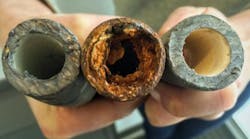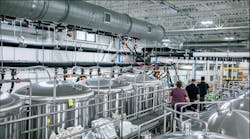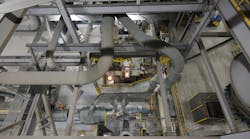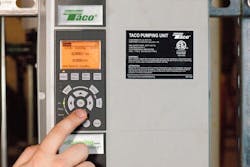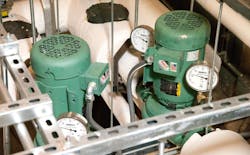Located at the “elbow” of Cape Cod, where the peninsula points north, is the quaint seaside town of Orleans, Mass. Although the Atlantic Ocean wards off the wicked cold inland towns above the 42nd parallel often experience, Orleans still has a longer heating season than most towns along the East Coast.
For years, Nauset Public Schools administrators had been considering an upgrade of the hydronic system at Orleans Elementary School, where a decades-old cast-iron boiler serving more than half of the school’s floor plan was at the end of its service life.
“Parts were getting scarce, efficiency wasn’t anywhere near what’s available today, and there was no redundancy,” Orleans Elementary Facilities Manager Ron Collins said.
In the spring of 2013, the district concluded the time for an overhaul had come.
The new design includes self-sensing pumps that take the place of a full-scale controls package at a fraction of the cost.
“With pumps that can sense and respond to pressure changes within a hydronic system, you not only eliminate DDC (direct digital control) controls from the picture, but there are both electric and thermal-efficiency gains,” Martin H. Vickey, PE, LEED AP, president of Taunton, Mass.-based mechanical-engineering firm C.A. Crowley Engineering Inc., said. “You have an even bigger advantage in a retrofit like this one.”
Running in Place
The original 30,000-sq-ft “‘56 Wing” of the building uses a primary/secondary system to supply commercial fin-tube baseboard radiators and unit ventilators. Each of the 24 classrooms has its own thermostat. Add plenty of common area and office space to the mix, and there is more than enough going on in the building to justify installation of a DDC platform.
With controls, sensors throughout the building could communicate with variable-speed pumps in the mechanical room, changing flow to meet demand in real time. But there was no room in the budget for controls. Nor was there time.
Often, centrifugal pumps are specified for maximum flow rate, and they spin non-stop for the entire heating season, regardless of whether there is a call for heat. That was the case at Orleans Elementary before the retrofit.
Overpumping is an issue in countless buildings across the country. For many such facilities, installation of a controls system simply is cost-prohibitive. At Orleans Elementary, there would have been the added cost of replacing otherwise healthy pneumatic zone valves because there would have been no simple way for the valves to interface with DDC.
Continuously spinning pumps waste a lot of energy, as do the often uninsulated secondary loops in 1950s buildings like Orleans Elementary, which see a higher standing heat loss when water is circulating. Controllability is marginal because pressure across valves is wholly at the mercy of the system, varying based on the number of other zones open at the time.
By slowing or stopping pumps, millions of revolutions can be eliminated per heating season, which drastically extends the life of pumps, seals, and bearings.
“Because these pumps modulate with building demand, they’ll run on average at half design speed,” Bryan Payne, PE, regional sales manager for hydronic-systems provider Taco Inc., said. “That’s conservative because the building is at partial load a vast majority of the time. Even on a design day, most of the hours are spent at low speed.”
This translates into major savings in wear and tear. A 1,750-rpm-design pump will save at least 225 million cycles per heating season.
Modulate, Condense, and Modulate Some More
The school’s mechanical room now houses three 700-MBH Lochinvar modulating condensing boilers. Set up in a standby configuration, they provide the desired redundancy and thermal efficiency. The boilers are piped together to form a 5-in. boiler (primary) loop.
Closely spaced Ts connect the primary loop to the 4-in. secondary loop, which is pressurized by a redundant set of 3-hp Taco SKV2007 SelfSensing pumps. Each includes a motor-mounted variable-frequency drive (VFD) to deliver the precise amount of flow and pressure needed, regardless of the number of zones calling.
The pumps accurately respond to changes in system demand without the need for pressure sensors. If a classroom zone valve closes, the pumps sense the change and ramp down according to the lower demand. Immediately, the pressure gauge on the supply side starts to drop.
“Before Taco’s SelfSensing pumps are shipped, the VFD are programmed at the company’s Cranston, R.I., factory according to data collected for specific flow rates, head pressures, and system characteristics,” Jeff Dirksen of Randolph, Mass.-based manufacturer’s representative Emerson Swan Inc. said. “A specific program enables the pumps to ‘know’ exactly what speed to run at any given time. You get tremendous energy savings this way.”
Taco’s SKV line of SelfSensing pumps comes in standard sizes from 1.5 hp to 60 hp, while the SKS line goes up to 250 hp.
The pumps’ ability to detect and respond to pressure fluctuations in a system puts the pumps on a level playing field with a DDC system coupled with standard variable-speed circulators.
“From a design standpoint, self-sensing pumps provide more leeway in pump selection since the pump will adjust to the need,” Vickey said.
Tight Squeeze
The new boilers share the mechanical room with a stand-alone Bradford White gas-fired water heater and more near-boiler piping than the old boiler required.
“There wasn’t a lot of room to play with,” Ed O’Keefe, pipefitter and start-up technician for Weymouth, Mass.-based mechanical contractor Enterprise Equipment Company Inc., said.
O’Keefe continued: “The Taco SelfSensing pumps were easy to install—no programming or commissioning. You wire it like a factory-packaged piece of equipment, turn it on, and that’s it. We did run into one problem, though, up near the ceiling, where the secondary loop comes into the boiler room.”
National electrical code mandates 3 ft of clearance from VFD for access to control panels. Because the pumps come from the factory with the VFD mounted on the side of the motor, O’Keefe had to remove the drive, extend the wires, and mount the drive on the wall with a Unistrut metal frame.
The Indian summer of 2013 and the retrofit project drew to a close simultaneously.
Tax Dollars Well Spent
The district expected the new boilers and pumps to reduce energy costs by at least 50 percent. Given the length and severity of the 2013-14 winter, savings should exceed initial estimates.
According to Payne, the energy consumed in the circulation of water during the heating season should fall by more than 70 percent.
Dan Vastyan is an account manager for Common Ground, a trade-communications firm based in Manheim, Pa.
For Design Solutions author guidelines, call Scott Arnold, executive editor, at 216-931-9980, or write to him at [email protected].


